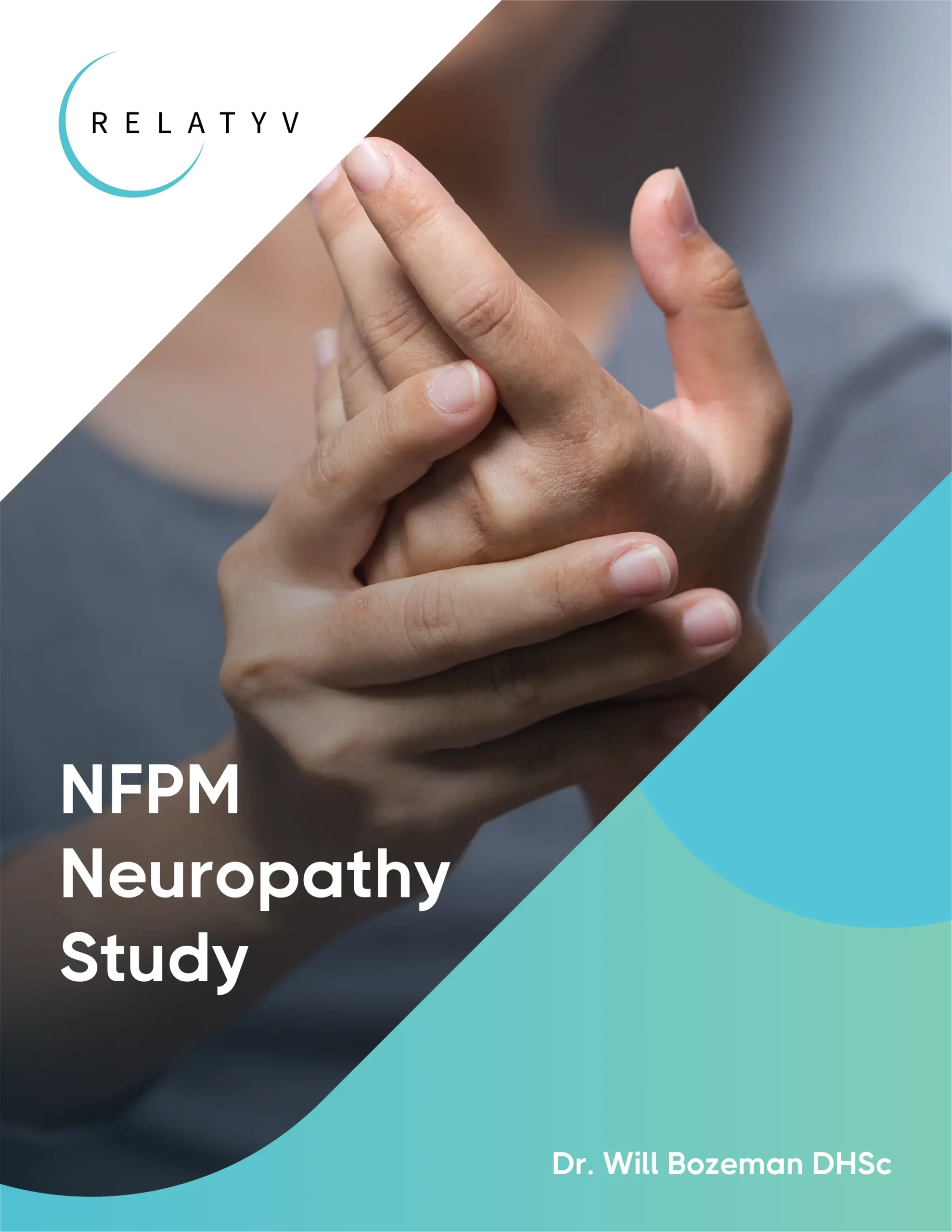Living with restless leg syndrome (RLS) can be challenging and disruptive to daily life. It is a neurological condition that can make it challenging to fall asleep or stay asleep, which can have a significant impact on your quality of life. For example, it can lead to daytime drowsiness, irritability, and difficulty concentrating, all of which can affect work performance and personal relationships. Fortunately, there are several ways that you can manage the symptoms and improve your overall well-being.
Our Neuragenex NFPM protocol focuses on the neurological factors of a wide range of conditions to help manage chronic pain and inflammation. As such, our protocol is well-suited to provide relief for those suffering from RLS.
What Is Restless Leg Syndrome?
Restless leg syndrome is a common, yet often misunderstood, condition that affects the nervous system. It is classified as a neurological disorder, due to its impact on the body’s nerve signals and functions. RLS is characterized by the urge to move one’s legs, usually accompanied by uncomfortable sensations in the lower limbs.
Who Experiences Restless Legs Syndrome
RLS affects approximately 7 to 11% of the Western population. While anyone can develop RLS, it is more commonly seen in women, older adults, and those with a family history of the condition. It’s also important to note that about two-thirds of those affected experience RLS as the primary condition, while the remaining third may experience it as a symptom of an underlying condition.
How It Affects The Body
Aside from the physical discomfort, RLS can also have an emotional impact on those who experience it. The constant urge to move can cause frustration, irritability, and difficulty sleeping. Lack of sleep and constantly disrupted rest can lead to fatigue, decreased concentration, and even depression in some cases.
Recognizing The Signs And Symptoms
RLS can present differently for everyone, but common symptoms include:
Leg Twitching
Some individuals may experience involuntary leg movements, such as twitching or jerking, during the night or while trying to fall asleep.
Urge To Move
The primary symptom of RLS is an uncontrollable urge to move the legs. These movements are often described as a crawling or creeping sensation in the legs, and they typically occur when you’re lying down or sitting for long periods.
Tingling And Burning Sensations In Legs
It is also common for individuals with RLS to experience tingling, burning, or itching sensations in their legs. Such sensations can be mild or severe and can produce discomfort and restlessness.
Pain And Discomfort In Arms Or Legs
While the name suggests that RLS only affects the legs, some individuals may also experience symptoms in their arms. These sensations can be just as uncomfortable and disruptive to daily life.
Back Pain
In some cases, RLS can also cause lower back pain, making it difficult for individuals to find relief by changing their position or moving their legs.
Urge To Scratch Legs
RLS can also lead to an urge to scratch or rub the legs. Constant scratching can damage the skin and lead to further discomfort.
Causes Of Restless Leg Syndrome
The cause of RLS is still unknown. However, researchers have identified several factors that could contribute to its development. These include:
Genetic Factors
RLS is believed to have a genetic component, as it tends to run in families. Studies have identified specific gene variations that may increase the risk of developing RLS.
Neurological Abnormalities
RLS is thought to be related to abnormalities of the nervous system, which disrupt the normal signaling and processing of sensations. For example, individuals with RLS may have lower levels of dopamine. Dopamine is a chemical in your brain that helps with controlling muscle movement.
Kidney Failure
In rare cases, RLS has been linked to kidney failure. This is because individuals with kidney disease may have an imbalance of iron and other minerals in their blood, which can contribute to RLS symptoms.
Iron Deficiency Anemia
Iron is essential for producing dopamine and plays a role in nerve signaling. Therefore, individuals with iron deficiency anemia may be more likely to develop RLS.
Deficiency In Cortisol
Cortisol is an important hormone in the body that is meant to help regulate stress and inflammation. Low levels of cortisol have been linked to RLS symptoms, as it may impact nerve signaling and muscle movement.
Factors That Heighten The Risk Of Developing RLS
There are numerous risk factors that could increase the likelihood of developing RLS, including:
Genetic Background
As mentioned earlier, having a family history of RLS can increase the risk of developing the condition.
Attention Deficit Hyperactivity Disorder (ADHD)
ADHD is a neurodevelopmental disorder that affects your ability to focus, control impulsive behaviors, and regulate emotions. It’s been shown that there is a connection between ADHD and RLS, with ADHD being an independent risk factor for developing RLS, as both conditions have been linked to abnormalities in dopamine levels.
Pregnancy
Pregnant women often experience RLS symptoms, especially in the third trimester. This may be due to hormonal changes or increased pressure on the legs.
Dialysis
Dialysis is a medical treatment used to filter waste and excess fluid from the blood when the kidneys are no longer able to function properly. Individuals undergoing dialysis may have an increased risk of developing RLS due to imbalances in iron and other minerals in their blood.
Anxiety Disorders
Anxiety disorders are mental health conditions characterized by excessive worry, fear, and tension. Anxiety can disrupt sleep and contribute to RLS symptoms due to increased muscle tension and stress on the nervous system.
Medications
Certain medications, including antihistamines and antidepressants, can worsen RLS symptoms or trigger them in individuals who are at risk for developing the condition. This is because such medications can impact dopamine levels and nerve signaling.
Medical Conditions
Several medical conditions may increase the risk of RLS, including:
- Osteoarthritis: This condition is known to cause chronic joint stiffness and pain. These symptoms make it difficult for individuals to find comfortable positions and may lead to RLS symptoms. Additionally, medications used to treat osteoarthritis can also worsen the symptoms of RLS.
- Rheumatoid arthritis: Similar to osteoarthritis, rheumatoid arthritis can cause joint pain and stiffness that may contribute to RLS symptoms due to difficulty finding comfortable positions and potential medication side effects.
- Peripheral neuropathy: This condition involves nerve damage and can cause sensations of tingling, burning, or pain in the legs. It is estimated that up to one-third of individuals with peripheral neuropathy also experience RLS symptoms.
- Fibromyalgia: This condition can result in chronic pain and fatigue, and it has been linked to RLS symptoms in some individuals due to increased muscle tension and nerve signaling disruption.
Diagnosing Restless Leg Syndrome
In addition to asking about your medical history and symptoms, a doctor will perform the following to help diagnose RLS:
- Neurological exam: A neurological exam is a series of tests to assess the function and health of your nervous system (which includes the evaluation of your brain, spinal cord, and nerves). This can help doctors rule out other potential causes of RLS symptoms.
- Physical exam: A physical exam will be done to check for any underlying medical conditions contributing to your RLS symptoms. For example, a doctor may examine your skin and reflexes for signs of anemia or nerve damage.
- Blood tests: Blood tests can be ordered to help identify any potential underlying medical conditions or deficiencies that may be causing RLS symptoms. These tests may include checking on iron levels, thyroid function, and kidney function.
How Restless Legs Syndrome Is Commonly Managed
RLS is a relatively common condition, which means that various management strategies are available. Some of the most common approaches recommended by more conventional doctors include:
Practicing Good Sleep Hygiene
Getting enough sleep and ensuring good sleep quality are essential for managing RLS symptoms. This includes going to sleep on a regular schedule, creating a sleeping environment that is comfortable, and avoiding activities that disrupt sleep. Doing so can help reduce the frequency and severity of RLS symptoms since getting enough rest can help regulate dopamine levels and decrease stress on the nervous system.
Engaging In Physical Activity
Regular physical activity can help to improve RLS symptoms by promoting better sleep and reducing stress. Additionally, exercise can help increase dopamine levels and promote overall nerve health by stimulating blood flow to the nerves. However, it is important to avoid exercising too close to bedtime as this may worsen RLS symptoms by increasing body temperature and adrenaline levels.
Minimizing Alcohol And Caffeine Intake
Both alcohol and caffeine have been linked to disrupted sleep patterns and may worsen RLS symptoms in some individuals. Both substances can impact dopamine levels and brain activity, increasing nerve signaling and muscle tension. Limiting or avoiding consuming these substances, especially close to bedtime, is recommended.
Applying Heat Or Ice Pack
Applying heat or ice packs to the legs can help relieve discomfort and reduce RLS symptoms. Heat can relax tense muscles, while cold can numb nerve endings and provide temporary relief from sensations.
Ensuring Adequate Intake Of Iron, Folate, And Magnesium
Deficiencies in iron, folate, and magnesium have been linked to RLS symptoms. Therefore, ensuring adequate intake of these minerals through a balanced diet or supplements is critical. However, consulting with a doctor before taking any supplements is crucial to avoid potential interactions with other medications.
Conventional Treatment Options
If the previously mentioned approaches are not effective, a doctor may recommend the following conventional treatment options for RLS:
Medications
There are many types of medications and supplements that can help alleviate RLS symptoms. However, keep in mind that many medications can cause various side effects. In addition, most medicines will only mask the symptoms and won’t address the underlying causes of your symptoms. That being said, the following medication options may be recommended to help manage RLS symptoms:
- Non-steroidal anti-inflammatory drugs: These medications can help reduce inflammation and leg pain that may contribute to RLS symptoms. However, they should be used cautiously, as long-term use can lead to gastrointestinal issues.
- Iron supplements: If blood tests show an iron deficiency, your doctor will likely recommend iron supplements to help increase your iron levels and help improve RLS symptoms.
- Dopaminergic agents: These medications can help regulate dopamine levels and reduce RLS symptoms. However, they may also cause side effects such as nausea, dizziness, and headache.
- Benzodiazepines: These sedative medications can help improve sleep and reduce muscle tension, leading to better management of RLS symptoms. However, they may also cause addiction and withdrawal symptoms.
- Anticonvulsants: These medications can help reduce nerve activity and promote relaxation, leading to improved RLS symptoms. However, they may also cause side effects such as drowsiness and dizziness.
- Opioids: In severe cases, a doctor may prescribe opioids to help manage RLS symptoms. However, these medications can be very addictive and should be used cautiously.
Cognitive-Behavioral Therapy (CBT)
CBT is a type of therapy that can help individuals identify and change thought patterns and behaviors contributing to their RLS symptoms. For example, a therapist may help someone reduce stress and anxiety by teaching relaxation techniques or creating a sleep plan to improve rest. This approach can help reduce stress levels, improve sleep, and manage RLS symptoms.
Pneumatic Pressure Therapy
Pneumatic pressure therapy involves wearing inflatable leg wraps that apply pressure to the legs, promoting better circulation and reducing RLS symptoms. This method can provide temporary relief from discomfort and help improve sleep quality.
Deep Brain Stimulation (DBS)
DBS is a surgical procedure involving the application of electrodes into specific areas of the brain to help regulate nerve activity and reduce RLS symptoms. This treatment option is only recommended in severe cases where other methods have been unsuccessful.
Living With Restless Leg Syndrome
While RLS is a chronic condition, it can be effectively managed with the proper treatment plan. Working closely with your doctor to find the best management strategies for your individual needs is essential.
How Neuragenex Neurofunctional Pain Management Tackle Restless Leg Syndrome Pain
At Neuragenex NFPM, we’ve developed a protocol that takes a whole-person, Neurofunctional Pain Management approach to treating pain and inflammation caused by conditions such as RLS. Our specialists focus on addressing the root neurological causes of your symptoms rather than just masking them with medication. For example, we use electroanalgesia to stimulate nerve pathways, increasing blood circulation and reducing pain signals to the affected area. This approach can provide long-lasting relief from RLS symptoms and improve overall nerve health.
Our team may also recommend dietary changes, IV therapy, and other non-invasive techniques to help manage your RLS symptoms effectively. Through our personalized treatment plans, we aim to improve your quality of life by addressing the underlying causes of your condition using drug-free, non-invasive, non-chiropractic, and non-surgical methods. Our Neuragenex NFPM protocol includes the use of the following treatment modalities:
Electroanalgesia
Electroanalgesia is a pain management technique that uses high-pulse electrical current to ease pain, boost blood circulation, improve mobility, and induce...
Read More About Restless Leg Syndrome (RLS) Electroanalgesia
IV Therapy
IV nutritional therapy, or intravenous therapy, involves administering vital nutrients directly to the bloodstream through an IV. This type of treatment bypasses the digestive system, allowing for maximum absorption and utilization of nutrients by the...
Lifestyle Counseling
Lifestyle counseling is an approach to managing chronic pain that involves identifying, assessing, and modifying lifestyle factors contributing to an individual's pain. For example, lifestyle factors such as nutrition, physical activity, stress, sleep quality...
Read More About Restless Leg Syndrome (RLS) Lifestyle Counseling
End Restless Leg Syndrome Pain
Restless leg syndrome can significantly impact an individual’s quality of life, but it doesn’t have to be a lifelong struggle. The proper treatment plan and lifestyle changes can help manage RLS symptoms. We take a unique approach to treating RLS by addressing the underlying neurological causes of your symptoms.
Our goal is to provide long-term relief from chronic pain and inflammation caused by conditions such as RLS. Our whole-person approach was designed to improve overall nerve health, so you can live a pain-free life. Contact us today to learn more about our Neurofunctional Pain Management protocol for RLS and other chronic pain conditions.
Ready to find relief from restless leg syndrome?



